2024-09-26|撰文者:Luchia Meihua Lee 李美華
Drawn in by the loud noise emanating from a video screen displaying the faces of 28 strangers, we notice that they are all speaking at once. In a strange way, their faces seem familiar. Upon closer inspection, we realize that these "strangers" are, in fact, leaders and celebrities from around the world. Upon gradually figuring out who these strangers are, viewers typically smile or laugh out loud, sparking an interest in exploring the ideas behind the artwork.
We notice that they are all speaking at once. In a strange way, their faces seem familiar. Upon closer inspection, we realize that these "strangers" are, in fact, leaders and celebrities from around the world. Upon gradually figuring out who these strangers are, viewers typically smile or laugh out loud, sparking an interest in exploring the ideas behind the artwork.
In this artwork by Pey-Chwen Lin, the faces of these celebrities merge with the AI-generated face of Eve Clone, resulting in distorted and grotesque appearances. In today's media-saturated world, we frequently see these public figures on news channels, talk shows, political interviews, and more. They become so embedded in our consciousness that they feel as familiar as our neighbors, relatives, or friends—even though we've never met them.
If we were to meet one of these celebrities in person, we might feel confused, doubtful, or even embarrassed for not immediately recalling his or her name, yet we'd be convinced that we should know it. This struggle can be unsettling. When we suddenly remember who he or she is, we're startled by the realization that the person we see so often on TV isn't actually a friend. This phenomenon reveals the deep and often unnoticed impact of public figures on our daily lives.
The 28 faces of the Eve Clone Wannsee Conference I, modeled after real renowned individuals and made immersive through AI, are a powerful representation of how these familiar strangers occupy our minds.
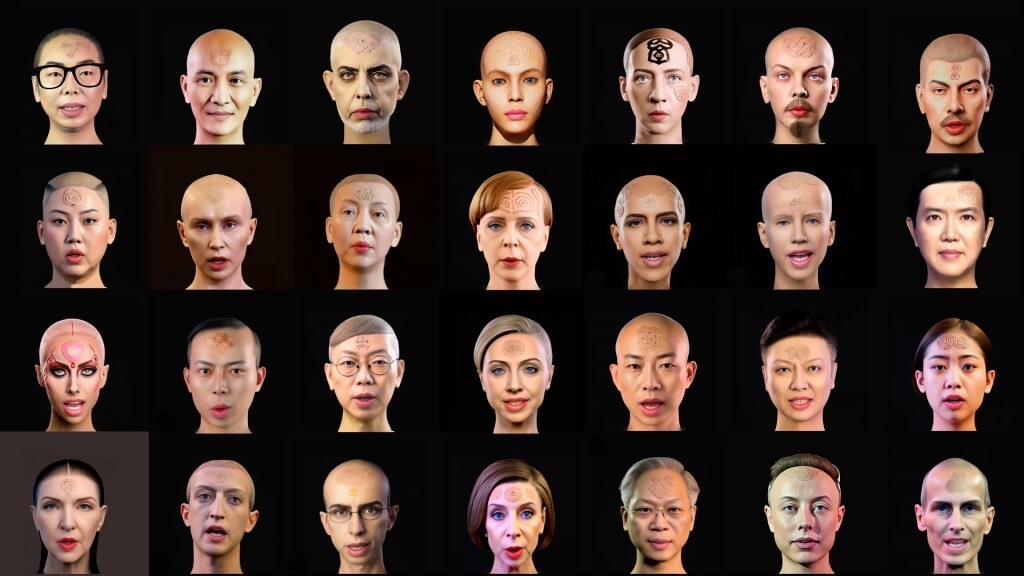 “Eve Clone Wannsee Conference I”
“Eve Clone Wannsee Conference I”
Media:3D Animation, AI Software, Photos, YouTube Videos
Length: 4:43
2024
YouTube: https://youtu.be/RszcUb6gkOA
Human vs. AI: Visitor Experience from Concept to Reality
Let us turn to the question that Immanuel Kant deemed central: "What is the human being?"(i) This universal question has never lost its relevance. Part of the answer is that being human means embracing cultural diversity while valuing people as individuals. It also means holding on to aspirations despite the accidents of birth. Another aspect involves a reverence for natural and social systems, as explored through artistic discourse. Socrates identified five core values—virtue, moderation, justice, courage, good, and piety(ii) —will we be able to pursue these ideals in the future? Are these questions still pertinent, or will our understanding of humanity be reshaped in an era where AI or clones may follow different standards?
It has become fashionable to predict that our future—and increasingly, our present—belongs to high technologies such as AI, VR, and AR. In this vision, ethnicity and other humanistic concerns seem poised to dissolve into a utopian future. However, Stephen Fry argues that we are living on a flood plain, and a great storm is coming.(iii) Most urgently, and perhaps counter-intuitively, in order to prepare for a future brimming with technology, we must intensify our efforts to understand what it means to be human, what machines can and cannot do, and which of our priorities they can support.
Art and humanity are more crucial than ever. We need to comprehend our soul, spirit, sense of beauty, love, inspiration, loyalty, and empathy. The widespread use of machines will afford us much more time, making it vital to understand how and why we can fulfill our true destiny.
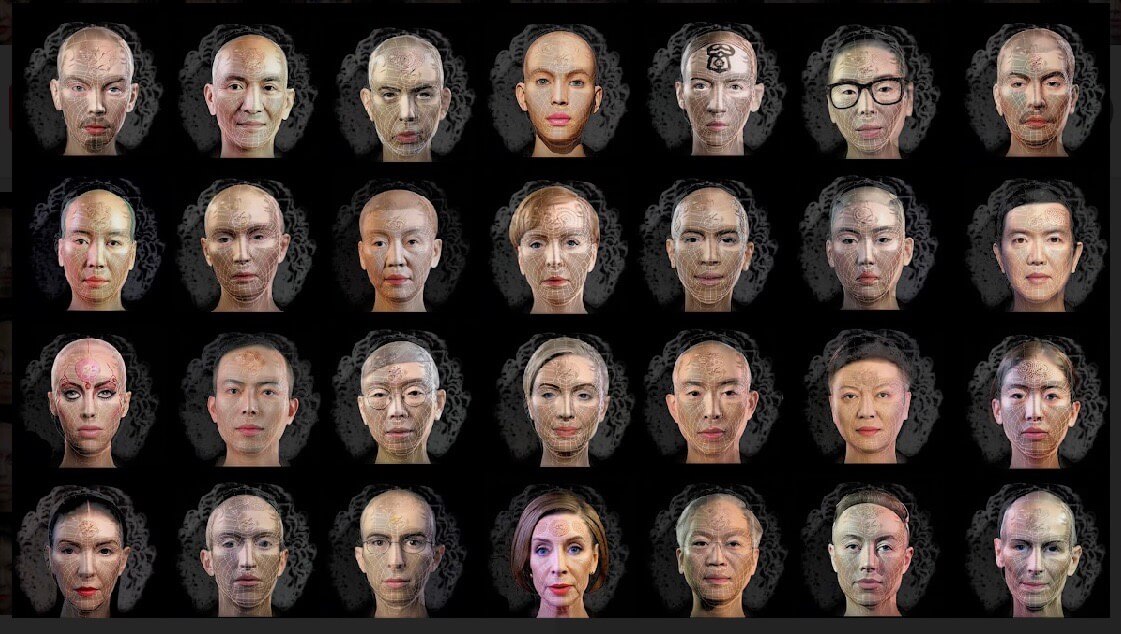 “Eve Clone Wannsee Conference I”
“Eve Clone Wannsee Conference I”
Media:3D Animation, AI Software, Photos, YouTube Videos
Length: 4:43
2024
YouTube: https://youtu.be/RszcUb6gkOA
A Conversation with No Talk
This concept reminds us that AI-generated images of world leaders and celebrities—like those from the Eve Clone Wannsee Conference I—represent real people who have been merged into a created entity known as Eve Clone. Just as advanced technology and creative science from computer labs can generate an Eve Clone, a single DNA-enabled cell can develop into a real human being, regardless of that human's mental or spiritual qualities. While we are aware that an Eve Clone may be on the horizon, it might not appear in the form of a robot. Instead, she could take control of life patterns or operate in invisible time and space. In contrast, as humans, the beings of superior essence, our moral considerations will determine how far we allow this progress to go. The real question lies in navigating these possibilities: how a community can both pretend and protect, and what strategies are necessary to prevent these scenarios from becoming reality, as the artist Pey-Chwen Lin references from a Bible chapter?
In our current world, complexities arise across continents and various regions. Sadly, in the name of protecting their own people, national leaders often make claims that lead to conflict, resulting in the killing or kidnapping of members of other ethnic groups. This cycle fuels wars, leading to the deaths of thousands of civilians. Large countries like the United States or those in the European Union express concern for global peace while simultaneously providing high-tech weapons that contribute to violence. Thus, the great powers showcase their military might and demonstrate their capacity to dominate the world.
In Pey-Chwen Lin’s Eve Clone Wannsee Conference I, Eve Clone stands at the center, symbolically controlling the scene, surrounded by 27 figures representing power in politics, military, economy, technology, and culture. They seem to be collectively manipulated by the system in a virtual world, each speaking their own language. The Wannsee Conference (Wannsee Konferenz in 1942) was originally a meeting where Nazi officials discussed and planned the systematic extermination of Jews. In contrast, Pey-Chwen Lin's presentation of the dialogue-less Eve Clone Wannsee Conference I satirizes the real world. In reality, many world leaders also participate in forums, proud to engage in discussions and meet other celebrities, earning recognition. These meetings also attempt to recruit more influential global leaders, with these figures collectively controlling the world’s finances, politics, media, economy, and society. Yet, in this meeting, there is no real communication—only the meaningless mumbling confusion of languages, akin to the Tower of Babel.
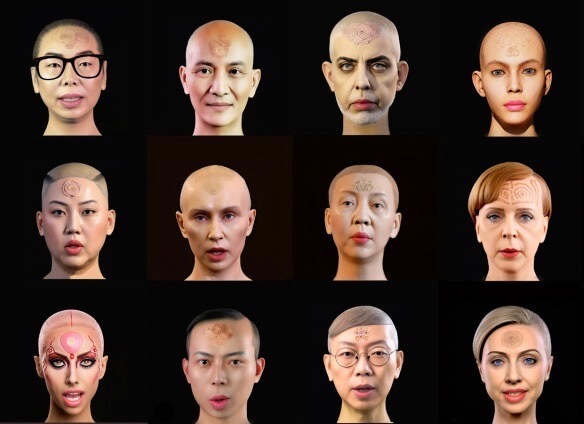 “Eve Clone Wannsee Conference I”
“Eve Clone Wannsee Conference I”
Media:3D Animation, AI Software, Photos, YouTube Videos
Length: 4:43
2024
YouTube: https://youtu.be/RszcUb6gkOA
We have witnessed various youth movements around the world over the past decade: the Arab Spring, the Chilean struggle for educational rights, Ukraine’s revolution for independence, Taiwan’s Sunflower Movement, and the most famous but ultimately failed Hong Kong Umbrella and Anti-Extradition protests, which aimed to protect city’s democratic independence from China. Despite involving two million people, it ultimately succumbed to China’s power. In many of these movements, artists have used different methods to participate and express their concerns. Artists like Pey-Chwen Lin skillfully use new media art to expose these troubling trends and raise public awareness.
The Eve Clone character created by Pey-Chwen Lin is a critique of humanity’s desire to challenge God and elevate themselves to a god-like status, embodying various manifestations of human ambition. The dialogue spoken by the figures on screen consists of lines in which Satan challenges and boasts to God, taken from the movie Megiddo, which is based on the Book of Revelation’s account of the apocalyptic military conflict. In the video, the world leaders speak simultaneously in their own languages, until a wordless dialogue is initiated. Others mimic them until Eve Clone is the last to speak, bringing it to a close. During the looped playback of the exhibition, it’s hard to discern who is speaking in such a short time until the chaotic noise of the entire group speaking at once grabs the viewer’s attention. This cacophony symbolizes the lack of real communication and dialogue; while each person seems to rationally express their thoughts, they fail to consider whether anyone else understands. Although these familiar leaders appear to be democratically discussing important issues, in reality, there is no true intent to communicate. Is this a reflection of our current world? Tragically, this scenario of social corruption continues to surround us, gradually taking over the world and stripping us of our rights.
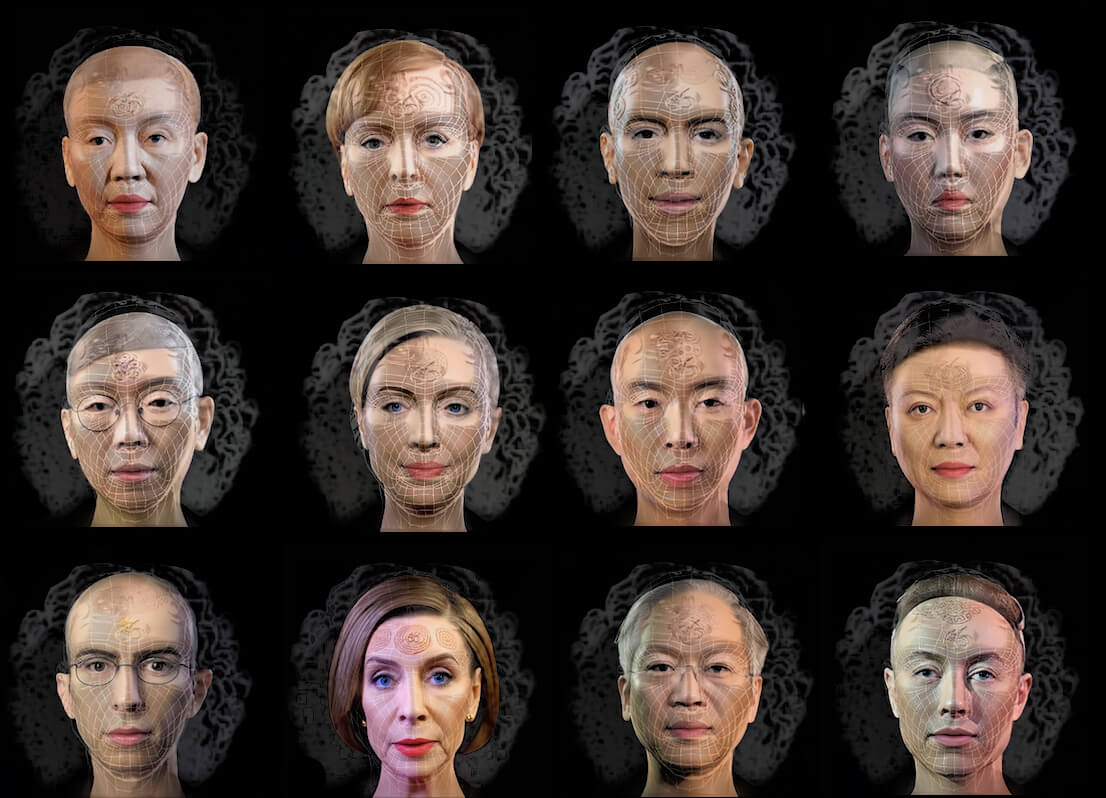 “Eve Clone Wannsee Conference I”
“Eve Clone Wannsee Conference I”
Media:3D Animation, AI Software, Photos, YouTube Videos
Length: 4:43
2024
YouTube: https://youtu.be/RszcUb6gkOA
Eve Clone on the Tower of Babel
In another new video piece, the Tower of Babel serves as the backdrop where a blue, awkwardly moving Eve Clone bends and stands atop the tower. According to the artist, this Eve Clone is dancing to show off. The blue Eve Clone continues to swing on top of the world's iconic skyscrapers, like Spider-woman climbing onto New York’s Empire State Building. One interpretation of "babel" is meaningless mumbling, and it also symbolizes the collapse of the last Babylonian empire. In this context, the Eve Clone Wannsee Conference I represents world leaders engaged in their own babble without any meaningful communication. This piece aligns with the Eve Clone Wannsee Conference I and other semiotic symbols to suggest a world headed toward collapse due to high technology, exemplified by the AI-generated Eve Clone. These AI world leaders, much like their human counterparts, seem to drag us toward a global disaster.
While innovative technology is often used to explore outer space, here it is employed to create an immersive, interactive art exhibition. In other contexts, AR and VR technologies engage visitors in a discovery of meteors and shifting universes through different time-space continuums. Pey-Chwen Lin's Eve Clone series, which she began developing in 2006, showcase innovative methods including VR, AR, AI, and motion capture photography that blend history, art, theology, digital engagement, and education. Her work reflects a mission to engage and inspire the community, echoing a Renaissance-like revival in the contemporary art world where form, concept, and technique are seamlessly intertwined.

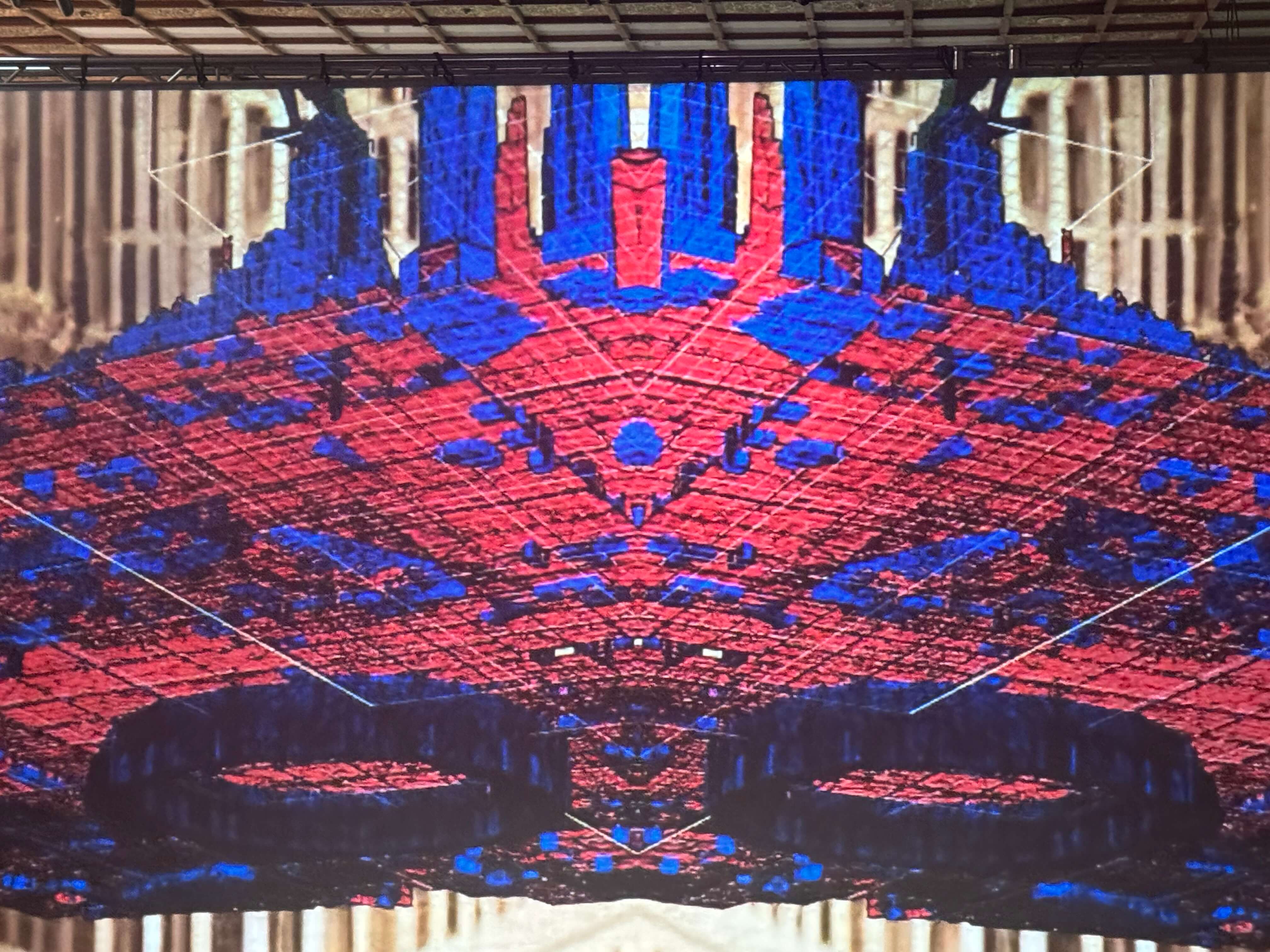 “Eve Clone Babel I”
“Eve Clone Babel I”
Media: 3D animation, digital sound effects, ancient images, dancers, and motion capture systems
Length: 4:06
2023
YouTube: https://youtu.be/KlekQHVCi7Y
Through seemingly traditional media such as drawing, mathematics, and literature writing—whether on paper or digital canvas—the artworks serve as a historical treasure hunt curated to create an intimate viewing experience. They delve deep into the connection between human beings and AI technology.
And one can sense how this innovative idea is both rooted in and expanded by the artist’s vision. Creators of new media art take on the role of bridging artistic creation with various fields, utilizing the mindset of an artist while also considering the practical aspects of engineering implementation. They manage each step of the process and evaluate the details to assess the success of the work’s presentation. This brings us back to the role of the Renaissance man or woman, who moves seamlessly across disciplines—embodying both an artist and a scientist—creating works that are simultaneously ancient and contemporary.
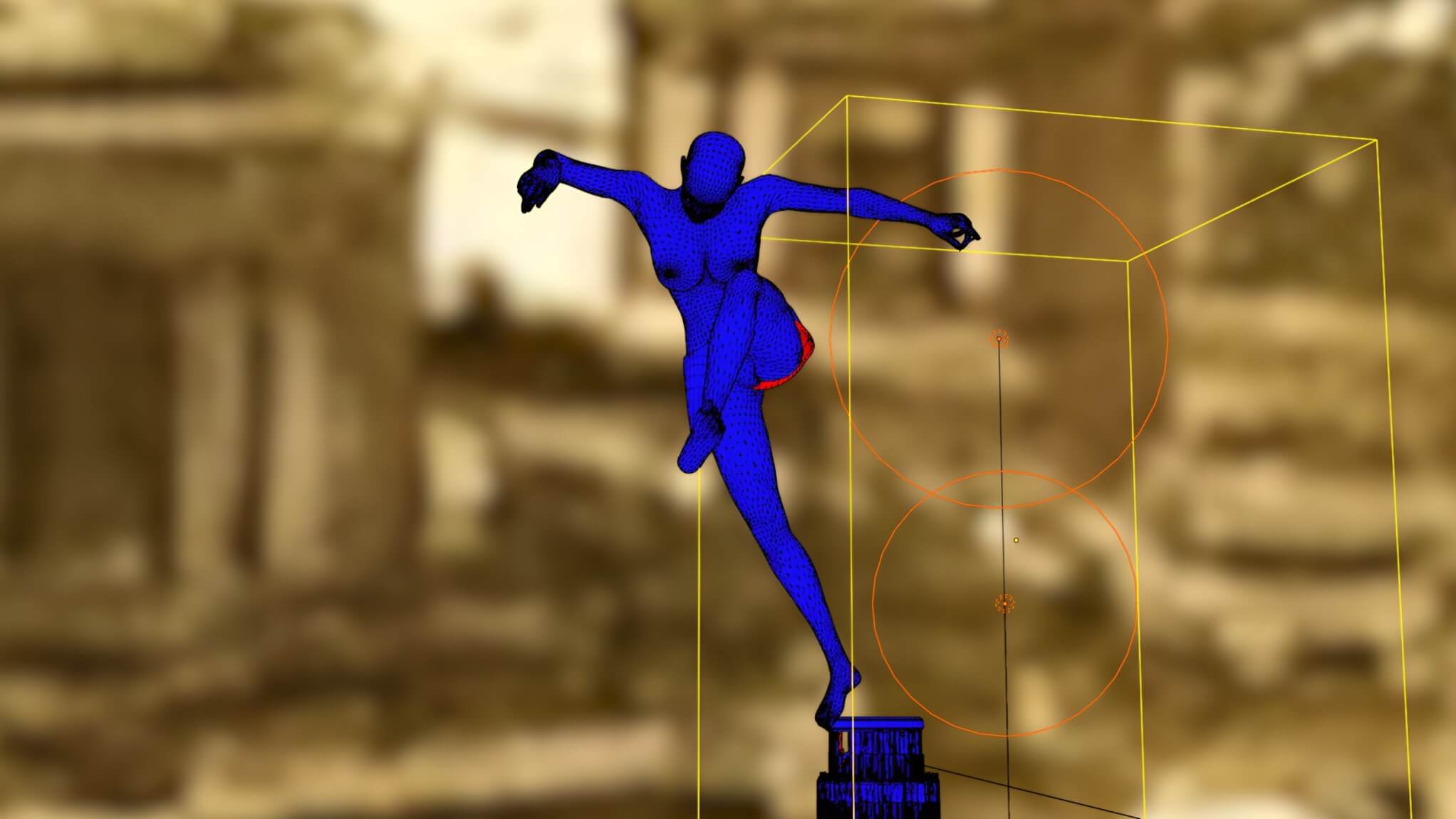
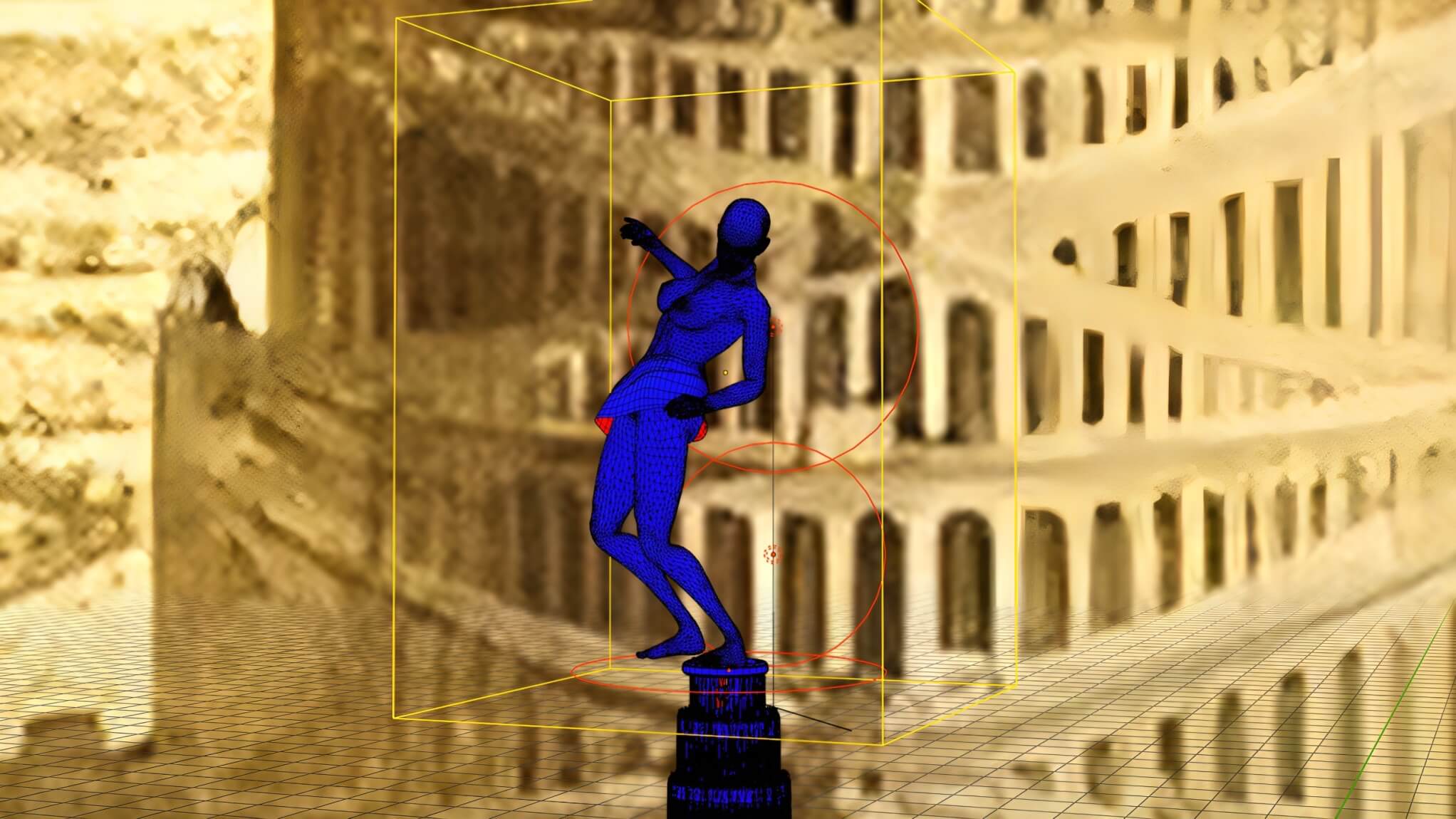 “Eve Clone Babel I”
“Eve Clone Babel I”
Media: 3D animation, digital sound effects, ancient images, dancers, and motion capture systems
Length: 4:06
2023
YouTube: https://youtu.be/KlekQHVCi7Y
Pey-Chwen Lin's Eve Clone on Governors Island, New York
In 2024, Pey-Chwen Lin was once again invited for a solo exhibition in New York, participating in the "Island Sunrise" annual thematic series hosted by the Taiwanese American Arts Council (TAAC) at Nolan Park on Governors Island. This event connects art from Taipei and New York. The curator Luchia Meihua Lee specifically arranged for a complete presentation of Pey-Chwen Lin’s Eve Clone series, including her 2017 video The Creation Project of Eve Clone I and augmented reality (AR) works featuring hands and heads. These were exhibited alongside two new works created this year: Eve Clone Wannsee Conference I and Eve Clone Tower of Babel I. In the meticulously crafted video projection The Creation Project of Eve Clone I, we witness the transformation from Leonardo da Vinci's Vitruvian Man to Eve Clone.
This year’s AI-generated video work, Eve Clone Wannsee Conference I, also demonstrates the consistency of Pey-Chwen Lin's conceptual ideas and the evolution of imagery. Eve Clone, the central female figure, serves as a hidden connection, and the 27 faces surrounding her evoke an eerie sense of both familiarity and strangeness. Pey-Chwen Lin skillfully blends Eve Clone with da Vinci's Vitruvian Man and the facial features of these authority figures using AI and 3D modeling software. The curly hair seen on the heads of the figures is reminiscent of the Vitruvian Man while still aligning with the feminine imagery. She also meticulously selected representative audio clips from these authority figures, which were then input into AI lip sync software (D-ID) to recreate their speech and expressions. The work reveals hybridized voices and the ambitious faces of these figures, with "666" inscribed on their foreheads, continuing the theme of the sinister mark.
Over the years, Pey-Chwen Lin's Eve Clone series has been recognized in numerous domestic and international exhibitions and has won over ten awards at international film festivals, including the Global First Prize in New Media Art at the XIIth Florence Biennale in Italy, as well as honors at the Cannes Film Festival and the Berlin Short Film Festival. The 2024 exhibition on Governors Island conveys the coherent creative concept behind Eve Clone, from the 2017 work The Creation Project of Eve Clone I to the new 2024 works Eve Clone Wannsee Conference I and Eve Clone Tower of Babel I. Visitors are able to experience and appreciate the deeper meaning behind the works. Since its opening in July 2024, the exhibition has garnered significant attention and feedback. In response to requests of the public on Governors Island, the exhibition has been extended and will now run until November 3rd.
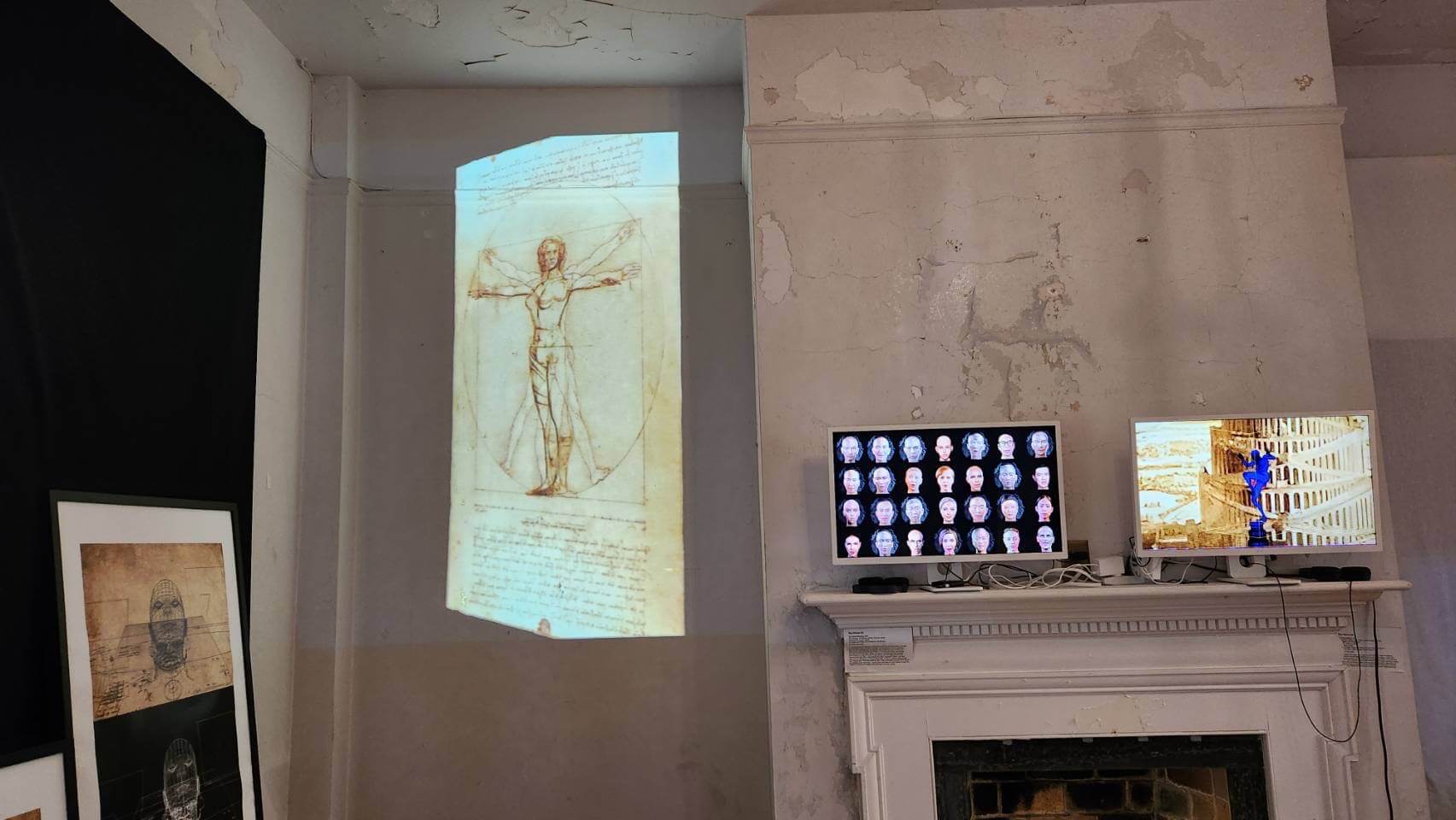
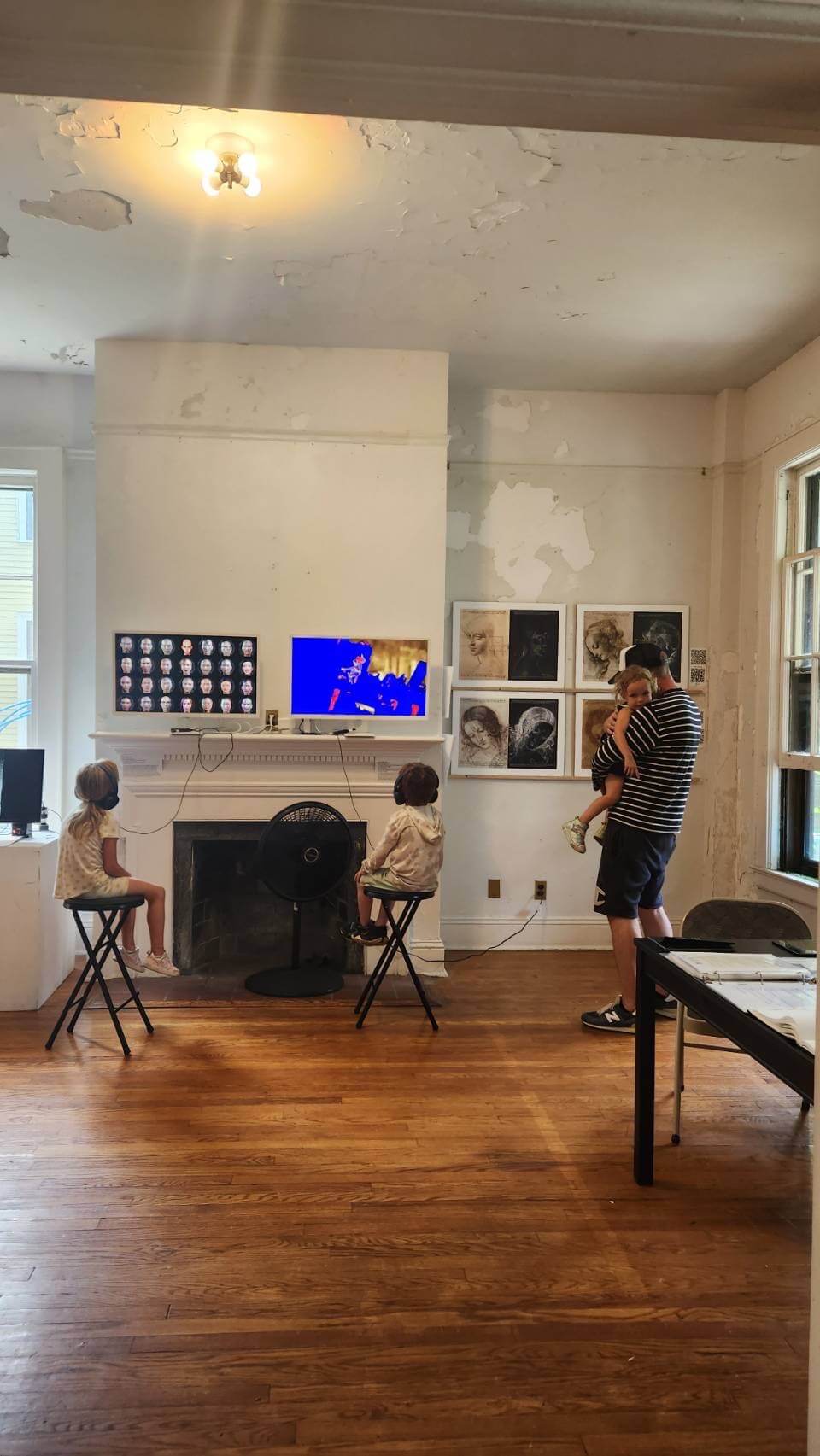
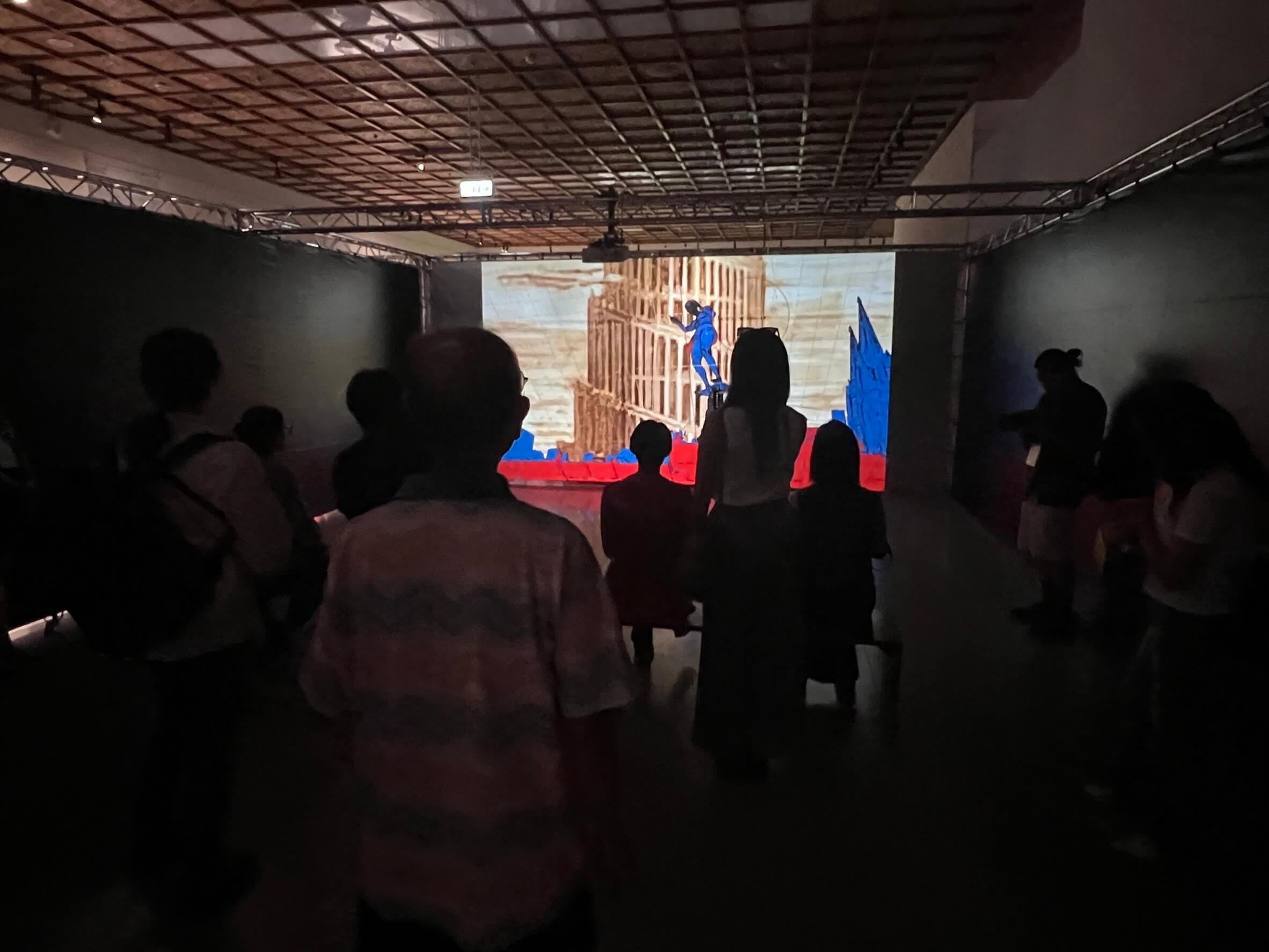
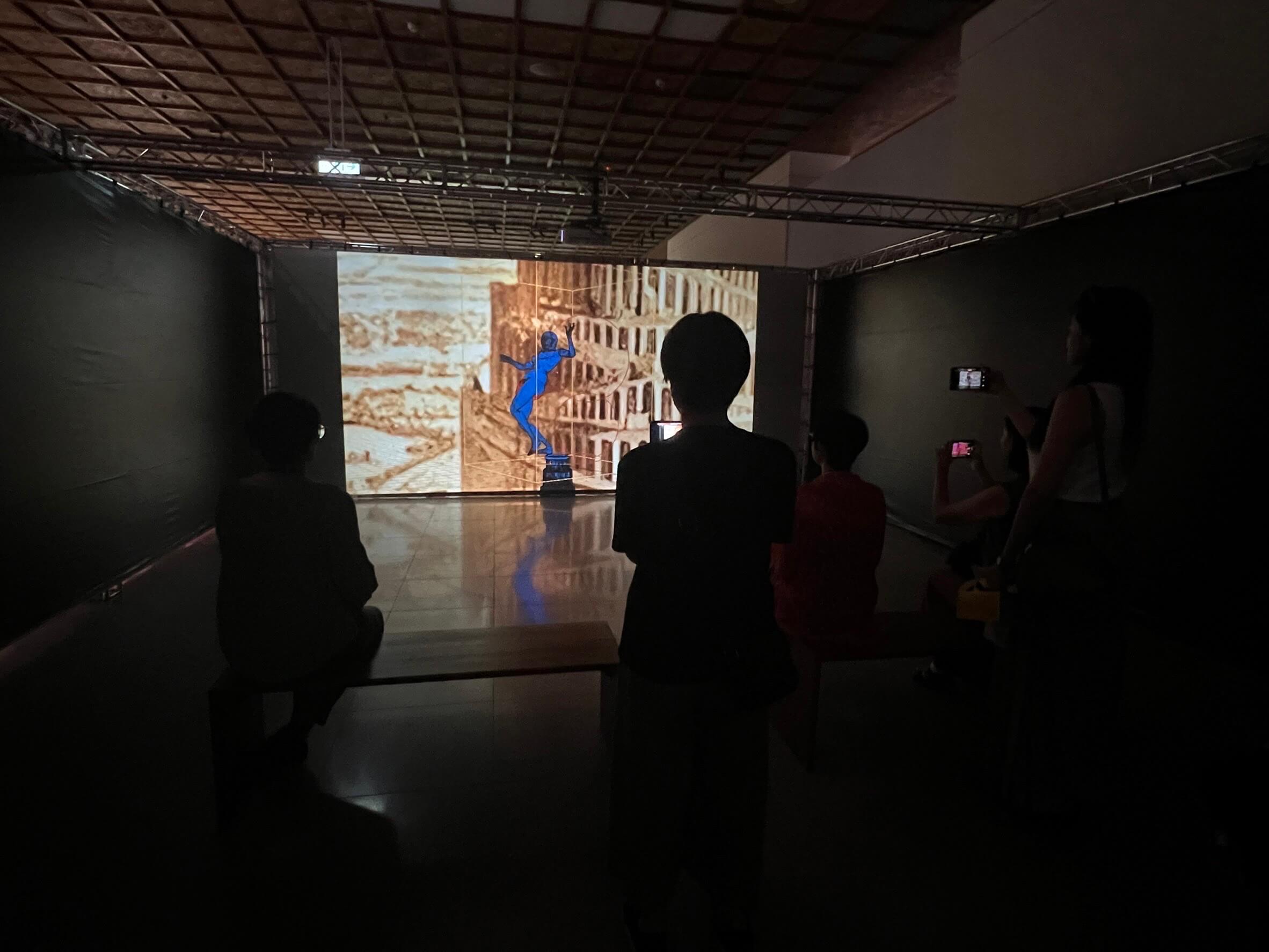
 New York:
New York:
"2024 Lin Pey-Chwen Solo Exhibition”, ‘ Island Sunrise’ , TAAC house 7b, Nolan Park, Governors Island, New York, USA
Curator: Luchia Lee Mei-Hua
Dates: 2024/07/18 ~2024/11/30
Eve Clone Series and Humanity
Since 2006, artist Pey-Chwen Lin has been developing her Eve Clone series, exploring the concept of clones—human-made beings that range from simple robots to today’s AI-enabled machines. As technology advances, we find ourselves gradually entering a world where we may need to defend moral principles. In this evolving landscape, it becomes increasingly difficult to distinguish between a fetishized, human-like mechanical creation and a lifeless, cold body. These entities are not confined to the virtual world; they are gradually becoming part of our reality. As they replace human labor, we are left questioning the fundamental value of being human.
When we lose sight of what it means to be human, even if we don't become an Eve Clone marked with "666" on the forehead, can our conscience rise and assert itself? At this critical crossroads, sharing both the world's blessings and misfortunes is a concrete and urgent social issue. Each day, new technologies are developed, and skills that seem mysterious or complex or kaleidoscopic can distract or mislead us. As a new media artist, Pey-Chwen Lin always aims to raise questions about human values in her work. Machines and equipment can continuously improve and evolve into sophisticated new technologies. However, the more pressing question is: What is the concept behind these artworks?
In an era where technological advancements blur the lines between human and machine, the Eve Clone series challenges us to confront the ethical, moral, and existential questions of our time. As we navigate a world increasingly dominated by AI and digital replicas, it becomes crucial to reassess our understanding of what it means to be human. The rise of these new technologies—whether in the form of cloned beings, AI-generated faces, or virtual realities—forces us to examine the core values of humanity: conscience, empathy, and morality. By raising these critical issues, the Eve Clone series compels viewers to consider the implications of our choices in shaping a future where technology serves as a tool for progress rather than a catalyst for dehumanization. In this way, the series becomes more than just art; it becomes a call to reflect on the delicate balance between innovation and the preservation of our fundamental human values.
About the author: Luchia Meihua Lee(Born in Taiwan, Lives and works in NYC)
Luchia Meihua Lee is a curator, cultural programming organizer, and arts writer dedicated to supporting and promoting diverse artists and creators in the field. She is the founding Executive Director of the Taiwanese American Arts Council. Residing in New York City since 1995, she has successfully curated many exhibitions and events along with a wide variety of lecture series in North America and elsewhere. During a span of over twenty years in New York, she has been curated many significant exhibitions at various museums, art organizations and galleries, been deeply involved in the contemporary art scene in the greater New York metropolitan area, and published catalogues and other written works.
She was Director and Chief Curator of the Exhibition Department of the National Taiwan Museum of Art, Cultural Specialist at the Council for Cultural Affairs (Cultural Ministry) in Taiwan, and Curator at the Chinese Information and Cultural Center (CICC, TECO in NY), Taipei Gallery in New York City. Her exhibitions received international media attention, in the New York Times, Wall Street Journal and many other places. Luchia Lee received her M. Phil in the History of Art and Architecture at Trinity College Dublin, Ireland with a thesis on Insular art, with a focus on the use of new technology for the exhibition of Medieval manus. She is committee member and art consultant for various organizations, and has served on many art juries for Queens Arts Council, LMCC, and several community art organizations.
Ms. Lee has been Executive Director of the Taiwanese American Arts Council (TAAC) since its founding in 2014, and continues to devote her professional efforts to support this non-profit organization that builds bridges between communities, nationally and internationally, through art and culture to deepen our senses of beauty, inspiration, and empathy.
REFERENCE
(Louden n.d.), Louden, Robert. n.d. 《康德的人性:論他的人性理論的隨筆》。牛津:牛津大學出版社。2019年5月4日取用。
(Philip C. 2003), 《蘇格拉底的六個問題:世界哲學的現代發現之旅》,麥田出版(城邦出版公司的一個部門)W. W. Norton & Company。April 17, 2005.
(Fry 2017), Fry, Stephen. 2017. 《相能傑出講座系列 - Stephen Fry,演員,喜劇演員,記者,作家》。10月3日。
(Louden n.d.), Louden, Robert. n.d. Kant’s Human Being: essays on his theory of human nature. Oxford: Oxford University Press. Accessed May 4, 2019.
Philip 2003), Six questions of Socrates: A Modern-Day Journey of Discovery through World Philosophy, Rye Field Publications, A division of Cite Publishing.
(Fry 2017), Fry, Stephen. 2017. Shannon Luminary Lecture Series - Stephen Fry, actor, comedian, journalist, author. Oct 3.
REACTIONS
0
0
0
0
0
熱門新聞
1
Taipei Dangdai 台北當代藝術博覽會 2025 展前熱身,展商名單及亮眼計畫公開,推出首屆《新生維度藝術家獎》
引領當代繪畫思潮!第三屆「中國信託當代繪畫獎」6/1起徵件-總獎金200萬 關渡美術館展出 獲獎作品進駐中國信託
114年「璞玉發光-全國藝術行銷活動」初選徵件4月7日開跑!
打造全民美術館!新北市美術館4月25日正式開館,4月8日起試營運,三大展覽搶先看
不只是燈火輝煌——邱杰森、莫珊嵐談「2025台灣燈會在桃園」中的藝術策展經驗
類比至數位時代的影像生產,北美館「時代劇場」探問當代影像的複數演繹
2025《巴塞爾藝術展與瑞銀集團環球藝術市場報告》:市場總值按年下跌,較低價位市場持續蓬勃,交易數量仍增加
川普祭出的「對等關稅」與「恢復美國歷史的真相與理智」將會對美國藝文產業帶來何種衝擊?
「亞洲獨立藝術空間歷史與檔案」國際論壇4月11日登場,國際策展人齊聚探討亞洲獨立藝術空間的發展
史博館「大家的歷史 歷史的大家」系列特展,從水墨、雕塑、油畫、版畫呈現臺灣藝術的多元樣貌
站內推薦
猜你喜歡
view all焦點新聞
當代藝術林珮淳新作《夏娃克隆巴別塔I 》甫獲2024坎城影展與歐洲短片影展入圍獎,又獲邀義大利Primo Piano LivinGallery 的國際當代藝術展「時光機器」
2024-05-08|撰文者:非池中藝術網編輯整理2704
焦點新聞
當代藝術個展藝術機構洪建全基金會三大計畫 點燃台北當代藝火 4月起接力推出委託、策畫鉅作——許哲瑜「災變論」、「Making of…Li Yi-Fan李亦凡」、李奧森「Stereoblind」
2025-04-10|撰文者:洪建全基金會 / 非池中藝術網編輯整理879